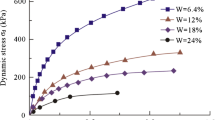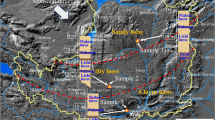Abstract
The damage caused by loess collapse after wetting is related not only to the magnitude of the collapse, but also to the resistance to and speed of the collapse. These factors are encapsulated in the concept of collapse sensitivity. However, there is no scientific and rational method available to evaluate it. To introduce this concept and develop a scientific evaluation method, four representative loess sites were selected in four different cities in China: Lanzhou, Xi’an, Taiyuan and Luoyang. Collapsibility tests were performed with loess samples from these sites. The concept of the collapse sensitivity of loess was introduced through the experiments, which involves the collapse magnitude, collapse speed and resistance to collapse. According to the physical significance of the concept, only two indexes, the time required to reach 90% of the collapse and the collapse potential under an appropriate pressure, were proposed to evaluate the collapse sensitivity of loess at a given site. The Chou Huang channel, which has collapsed, was presented as a case study to demonstrate the application and reliability of this method.








Similar content being viewed by others
Abbreviations
- d :
-
Diameter of the exploratory well
- e :
-
Void ratio
- G s :
-
Specific gravity of soil particles
- H :
-
Depth of the sampling point
- h n :
-
Wetting subsidence (mm) at the corresponding time points tn
- h(n − 1) :
-
Wetting subsidence (mm) at the corresponding time points t(n − 1)
- h 0 :
-
Initial height of the soil specimens
- h p :
-
Sample height of “unsaturated” soil specimens, subjected to a vertical pressure P
- \( {h}_p^{\prime } \) :
-
Sample height of “saturated” soil specimens, subjected to a vertical pressure P
- I c :
-
Collapse potential
- I e :
-
Collapse index
- I p :
-
Plasticity index
- I s :
-
Collapse sensitivity
- S r :
-
Saturability
- T :
-
Time of completing 90% of the total amount of settlement
- w :
-
Water content
- w L :
-
Liquid limit
- ρ :
-
Natural density
- ρ d :
-
Dry density
- ν :
-
Collapsibility deformation rate
References
ASTM International (2003) ASTM D2435-03. Standard test method for one-dimensional consolidation properties of soils. ASTM International, West Conshohocken, PA
ASTM International (2003) ASTM D5333-03. Standard test method for measurement of collapse potential of soils. ASTM International, West Conshohocken, PA
Buscarnera G, Di Prisco C (2013) Soil stability and flow slides in unsaturated shallow slopes: can saturation events trigger liquefaction processes? Géotechnique 63(10):801–817. https://doi.org/10.1680/geot.11.p.097
Cui YE (2010) Discussion on the issue of sensitivity of loess collapse. Coal Eng 8:76–78 (in Chinese). https://doi.org/10.3969/j.issn.1671-0959.2010.08.030
Delage P, Cui YJ, Antoine P (2005) Geotechnical problems related with loess deposits in Northern France. In: Proceedings of the International Conference on Problematic Soils, Famagusta, N. Cyprus, May 2005
Feng SJ, Du FL, Shi ZM, Shui WH, Tan K (2015) Field study on the reinforcement of collapsible loess using dynamic compaction. Eng Geol 185:105–115. https://doi.org/10.1016/j.enggeo.2014.12.006
Gao GR (1981) Classification of microstructures of loess in China and their collapsibility. Sci Sin 24(7):962–974
Gao GR, Gao GY (1980) Microstructures of loess soils in China. Chin Sci Bull 25(7):597–601
Gibbs HJ, Holland WY (1960) Petrographic and engineering properties of loess. Engineering Monograph 28, Bureau of Reclamation, United States Department of the Interior, Denver, CO, pp 1–37
Guan WZ (1983) Preliminary study on factors affecting the sensitivity of self-weight collapsible loess and its discriminant index. Site Investig Sci Technol 4:32–35 (in Chinese)
Haeri SM, Garakani AA, Khosravi A, Meehan CL (2014) Assessing the hydro-mechanical behavior of collapsible soils using a modified triaxial test device. Geotech Test J 37(2):190–204. https://doi.org/10.1520/GTJ20130034
Jiang MJ, Hu HJ, Liu F (2012) Summary of collapsible behaviour of artificially structured loess in oedometer and triaxial wetting tests. Can Geotech J 49(10):1147–1157. https://doi.org/10.1139/T2012-075
Kim D, Kang SS (2013) Engineering properties of compacted Loesses as construction materials. KSCE J Civ Eng 17(2):335–341. https://doi.org/10.1007/s12205-013-0872-1
Lawton EC, Fragaszy RJ, Hetherington MD (1992) Review of wetting-induced collapse in compacted soil. J Geotech Eng 118(9):1376–1394. https://doi.org/10.1061/(ASCE)0733-9410(1992)118:9(1376)
Liang C, Cao C, Wu S (2018) Hydraulic-mechanical properties of loess and its behavior when subjected to infiltration-induced wetting. Bull Eng Geol Environ 77(1):385–397. https://doi.org/10.1007/s10064-016-0943-x
Lutenegger AJ (2012) Collapse “sensitivity” of midcontinent and lower Mississippi Valley loess. Geocongress 225:880–889. https://doi.org/10.1061/9780784412121.091
Lv QF, Wang SX, Wang DK, Wu ZM (2014) Water stability mechanism of silicification grouted loess. Bull Eng Geol Environ 73(4):1025–1035. https://doi.org/10.1007/s10064-014-0646-0
Mihalache C, Buscarnera G (2015) Is wetting collapse an unstable compaction process? J Geotech Geoenviron 141(2):1. https://doi.org/10.1061/(ASCE)GT.1943-5606.0001226
Munoz-Castelblanco J, Delage P, Pereira JM, Cui YJ (2011) Some aspects of the compression and collapse behaviour of an unsaturated natural loess. Géotech Lett 1(2):17–22. https://doi.org/10.1680/geolett.11.00003
Rao SM, Revanasiddappa K (2002) Collapse behaviour of a residual soil. Géotechnique 52(4):259–268. https://doi.org/10.1680/geot.52.4.259.41025
Reznik YM (2007) Influence of physical properties on deformation characteristics of collapsible soils. Eng Geol 92(1–2):27–37. https://doi.org/10.1016/j.enggeo.2007.03.001
Rogers CDF, Dijkstra TA, Smalley IJ (1994) Hydroconsolidation and subsidence of loess: studies from China, Russia, North America and Europe: in memory of Jan Sajgalik. Eng Geol 37(2):83–113. https://doi.org/10.1016/0013-7952(94)90045-0
Sivakumar V, Wheeler SJ (2000) Influence of compaction procedure on the mechanical behaviour of an unsaturated compacted clay. Part 1: wetting and isotropic compression. Géotechnique 50(4):359–368. https://doi.org/10.1680/geot.2000.50.4.359
Thyagaraj T, Das AP (2017) Physico-chemical effects on collapse behaviour of compacted red soil. Géotechnique 67(2):559–571. https://doi.org/10.1680/jgeot.15.p.240
Wheeler SJ, Sivakumar V (2000) Influence of compaction procedure on the mechanical behaviour of an unsaturated compacted clay. Part 2: shearing and constitutive modelling. Géotechnique 50(4):369–376. https://doi.org/10.1680/geot.2000.50.4.369
Zhang Y, Hu ZQ, Yue WQ, Song ZY, Xue T, He XN (2017) Collapsible tests of loess under acid conditions and related sensitivity analysis. Chin J Rock Mech Eng 36(7):1748–1756 (in Chinese). https://doi.org/10.13722/j.cnki.jrme.2016.1061
Zhang Y, Hu ZQ, Chen H, Xue T (2018) Experimental investigation of the behavior of collapsible loess treated with the acid-addition pre-soaking method. KSCE J Civ Eng
Acknowledgements
Many people have contributed to this study of evaluating the collapse sensitivity of loess. Wang Yanhua, Yue Wenqing and Li Yang are acknowledged for their help in both technically and editorially revising the manuscript. This study was supported by the Science and Technology Innovation Project of the Key Laboratory of Shaanxi Province, China (2014SZS15-Z02).
Author information
Authors and Affiliations
Corresponding author
Additional information
Highlights
1. Collapsibility tests were performed with four typical collapsible loesses.
2. The concept of collapsible sensitivity was introduced with the tests in detail.
3. A method of assessing collapse sensitivity was proposed.
4. The method is simple and combined with current collapsibility test standards.
5. The method can be used to evaluate collapse sensitivity of a loess site.
Appendix
Appendix
Different structural and material characteristics of loess in different regions is the essential reason for the different collapse sensitivities of loess. The formation of Chinese loess is presented as an example to further introduce the concept of collapse sensitivity of loess.
The cold wind current from Siberia, influenced by Asian continental high pressure, blows to low-pressure areas in southeastern China. When the current passes through desert areas, it picks up sand grains in the air. They are further corroded into smaller particles of silt and clay by heat exchange with air and severe cold wind, then regularly deposited from northwestern to southeastern China, depending on the particle size (Fig. 1).
Due to the low relative humidity and low rainfall in arid and semi-arid areas of northwestern China (Lanzhou, Xi’an, Taiyuan), only a small amount of soluble salts (CaCO3 as the main content) in the loess are leached. A higher content of CaCO3 indicates that the soil particles are more rigid and that the structural strength of the loess is stronger under normal conditions. Therefore, shallow loess layers, specifically loess deposited during the Holocene (Q4) and late Pleistocene (Q3) periods, are difficult to fully compress. Insect holes and roots are abundant in these loess layers. Vertical and subvertical joints are also well developed. The microstructure of these loess layers is characterised by numerous macropores. The macrostructure of these loess layers is characterised by large e or small ρd values. After soaking, this shallow loess can rapidly and violently collapse under its own weight or an external load (Gao 1981; Gao and Gao 1980). In contrast, the deep loess layers, such as the Lishi loess and Wucheng loess, deposited during the Middle and Early Pleistocene (Q2, Q1), respectively, are fully compacted because of the high pressure exerted by the upper soil layers. The CaCO3 content in these loesses is relatively low, and the microstructure of these loess layers is characterised by the interlocking mode. The macrostructure of these loess deposits is characterised by small e or large ρd values. This loess is considered a non-collapsible loess, which practically exhibits no collapsibility.
The greater content of soluble salts in the loess of southeastern China (Luoyang), which features a humid climate and abundant rainfall, can be dissolved during long infiltration. The salts are then deposited at the bottom of the loess layer or drained directly beyond the borders. Due to the low CaCO3 content, the soil particles are not very rigid, and the structural strength of this loess is comparatively low and poorly supports the load of the thick upper soil. Therefore, the pore structure is gradually compacted into an interlocked structure, and the point contacts gradually change to cementation contacts. This type of loess, in both shallow and deep layers, has better compaction, as characterised by a higher ρd or lower e, and is difficult to further collapse, even when soaked (Gao 1981; Gao and Gao 1980).
Rights and permissions
About this article
Cite this article
Zhang, Y., Hu, Z. & Xue, Z. A new method of assessing the collapse sensitivity of loess. Bull Eng Geol Environ 77, 1287–1298 (2018). https://doi.org/10.1007/s10064-018-1372-9
Received:
Accepted:
Published:
Issue Date:
DOI: https://doi.org/10.1007/s10064-018-1372-9




